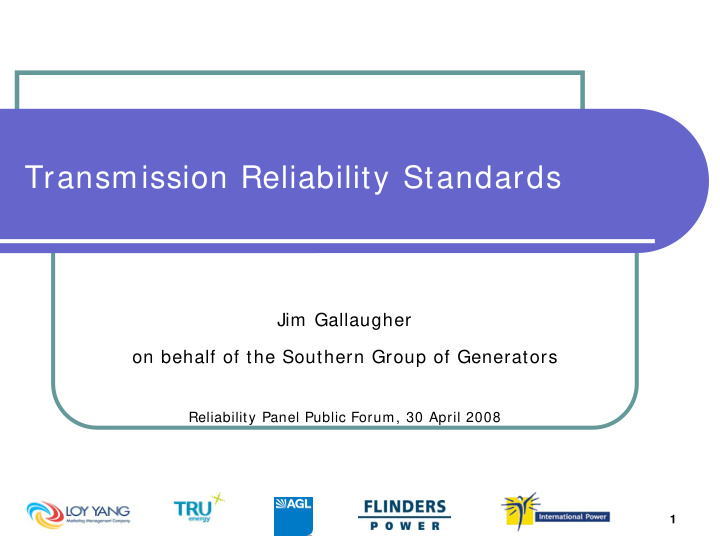



Transmission Reliability Standards Jim Gallaugher on behalf of the Southern Group of Generators Reliability Panel Public Forum, 30 April 2008 1
The I ssues � W hat constitutes “a nationally consistent fram ew ork”? � W hat are suitable high level principles to incorporate in the fram ew ork? � W hat is an appropriate form of transm ission reliability standard? 2
Nationally Consistent Fram ew ork “… “… the creation of a truly the creation of a truly national, efficient, national, efficient, sustainable and inclusive sustainable and inclusive economy supported by economy supported by seamless regulation …” 1 seamless regulation …” 1 “Australia 2020 Summit – Initial Summit Report”, April 2008 – Page 10 3
Nationally Consistent Fram ew ork ‘Minimalist’ ‘Seamless’ National Uniform Principles National Only Regulations & Standards Option Option Option Option Option A E B C D 4
Nationally Consistent Fram ew ork ‘ Minimalist ’ ‘ Seamless ’ National Uniform Principles National Only Regulations Reliability & Standards Panel TNSPs AER? The Group States VENCorp ESIPC NGF Energy Australia 5
Nationally Consistent Fram ew ork The stated case in favour of jurisdictional based standards: � Each State is different � State politicians ‘take the heat’ for supply failures � Consistency betw een transm ission and sub-transm ission standards is ‘im portant’ These parochial arguments are unconvincing and are generally only offered by those who have little or no interest in participating in the market beyond the borders of their home State 6
Nationally Consistent Fram ew ork Reliability Panel’s concerns w ith jurisdictional standards: � Entrenches jurisdictional specific netw ork planning � I ntra-jurisdictional TNSP planning focus � Jurisdictional differences in the econom ics of transm ission versus generation 7
Nationally Consistent Fram ew ork Jurisdictionally based standards = � Lack of com petitive neutrality betw een generation and transm ission � Needless com plexity � Needless retention of jurisdictional discretion � Potential for undue influence and discretion for TNSPs � Likely retention of sim plistic determ inistic standards 8
High Level Principles Broad Consensus Other Suggestions ? � Transparency � Effectiveness ( ETNOF) x � Governance � Robustness ( ETNOF) ? � Econom ic efficiency � Consistency [ c.f. Dist’n] ( ETNOF/ RP/ The Group) � Specificity x � No w orse ( RP) � “Fit for Purpose” � Technology neutral ( RP) � TNSP accountability 9
Form of Reliability Standard The 3 Options � Probabilistic � Determ inistic � Hybrid 10
Form of Reliability Standard The Group strongly favours a probabilistic standard because it is: � The only w ay to preserve com petitive neutrality betw een various com peting alternatives for m eeting the standard � Fully com patible w ith the NEM Objective and a proper value based investm ent test for new regulated investm ents � The option that can best satisfy m ost, if not all, of the proposed principles 11
Form of Reliability Standard The so-called ‘determ inistic’ standard is anything but determ inistic in that it is applied in a decision-m aking process involving planning futures that are inherently uncertain I n fact, as stated by VENCorp, a determ inistic standard in this planning context is nothing m ore than a ‘redundancy standard’ 12
Form of Reliability Standard Probabilistic based inputs into the application of a so-called determ inistic standard include: � Dem and forecasts ( generally 9 0 % POE) � A range of ‘typical’ patterns of generation dispatch based on a num ber of ‘plausible’ future generation investm ent scenarios � A range of plausible or credible system contingencies 13
Form of Reliability Standard The Group Reliability Panel A set of determ inistic A probabilistic standard � � standards based on applied w ithin a w ell- econom ic considerations defined, uniform planning – i.e. a hybrid approach m ethodology Possible use of an � econom ically based determ inistic surrogate in lim ited, w ell-defined, circum stances – clearly specified in the uniform planning m ethodology – there could be m any of these 14
Form of Reliability Standard � The theoretical correctness of the probabilistic approach is inarguable � I t’s detractors criticise it on the grounds of: � Com plexity � Practicality � Clarity in investm ent decision-m aking � Stakeholder Acceptance � That is, it’s an inconvenience, principally to TNSPs 15
Form of Reliability Standard The RP’s case against a probabilistic standard: � “… few pow er system s in advanced econom ies are developed in this w ay” � “… adoption of such an approach across the NEM w ould present m any challenges” � “… m ay be desirable for there to be a consistent relationship betw een transm ission and sub- transm ission standards” � “A very com pelling case w ould have to be m ade to governm ents and regulators to sw itch to probabilistic standards and planning m ethods …” 16
Form of Reliability Standard The Group’s position: � The probabilistic approach is theoretically correct � I t’s advantages ( in term s of satisfying the proposed principles) com pared to the alternatives are significant � The argum ents against it are unconvincing � VENCorp has dem onstrated that it’s doable, but w e acknow ledge their approach falls w ell short of an ideal probabilistic planning m ethodology � Needlessly settling for a “second best” approach sim ply because it’s convenient is likely to be very costly in the long run 17
Recommend
More recommend